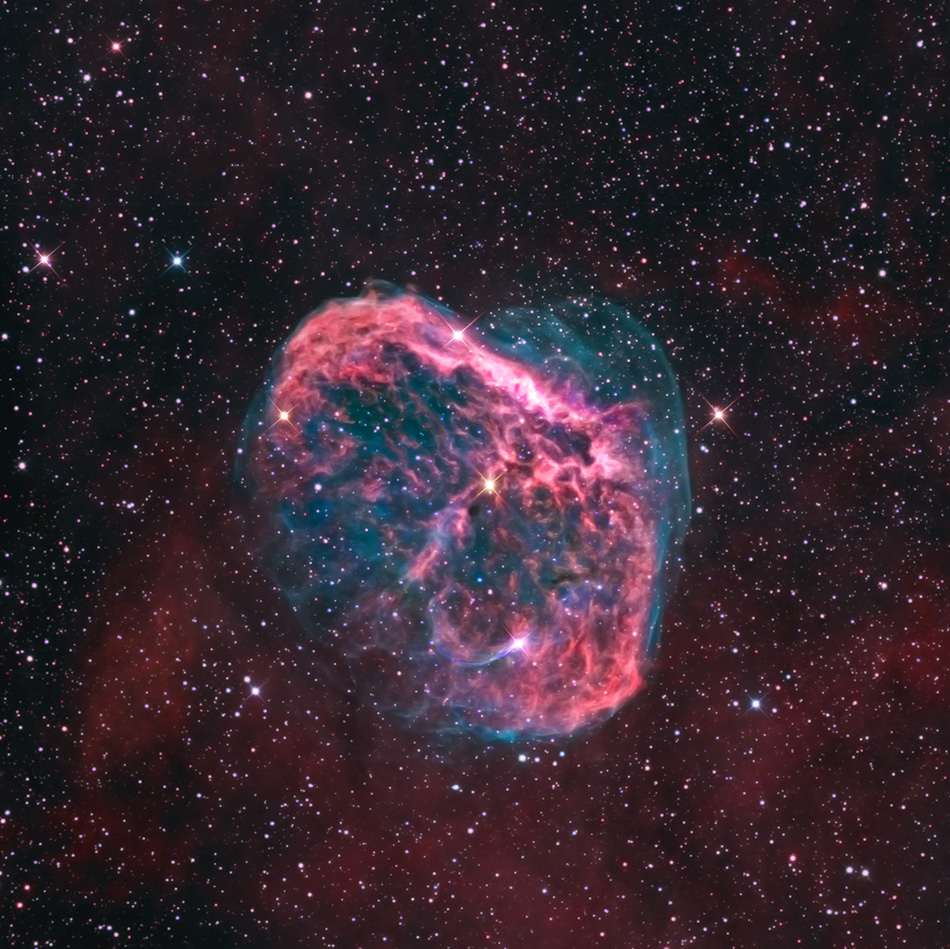NGC 6888 - The Crescent Nebula
Image Credit: Preston Starr and Donald Waid
NGC 6888 1,2,3
NGC 6888 is located in the constellation Cygnus1 approximately 6,700 light years2 from Earth and is known as the Crescent Nebula because of its distinctive shape. Technically, it is classified as a Wolf-Rayet3 nebula. Such a nebula is formed when a very hot, massive star ejects its outer layers in a strong stellar wind.2 In the case of the Crescent Nebula the star responsible,WR 136,2 is the bright star in the center of the image above. As the star ages it begins to shrink and grow much hotter. Its stellar wind becomes more rarefied but much faster. This fast stellar wind then collides with the older ejected gas and pushes it into a relative dense bubble. WR 136 is in the final stages of its stellar life and is destined to explode in a spectacular supernova event3.
The image above was captured using Ha and OIII filters. The image was assembled by mapping Ha to red, OIII to blue and green. The stars were overlaid with data from a Red, Green, and Blue filtered image.
1
NASA Science: https://science.nasa.gov/ngc-6888-crescent-nebula
2
Wikipedia: https://en.wikipedia.org/wiki/WR_136
3
IOP Science: https://iopscience.iop.org/article/10.1088/1742-6596/728/3/032007
NGC 6888 is located in the constellation Cygnus1 approximately 6,700 light years2 from Earth and is known as the Crescent Nebula because of its distinctive shape. Technically, it is classified as a Wolf-Rayet3 nebula. Such a nebula is formed when a very hot, massive star ejects its outer layers in a strong stellar wind.2 In the case of the Crescent Nebula the star responsible,WR 136,2 is the bright star in the center of the image above. As the star ages it begins to shrink and grow much hotter. Its stellar wind becomes more rarefied but much faster. This fast stellar wind then collides with the older ejected gas and pushes it into a relative dense bubble. WR 136 is in the final stages of its stellar life and is destined to explode in a spectacular supernova event3.
The image above was captured using Ha and OIII filters. The image was assembled by mapping Ha to red, OIII to blue and green. The stars were overlaid with data from a Red, Green, and Blue filtered image.
1
NASA Science: https://science.nasa.gov/ngc-6888-crescent-nebula
2
Wikipedia: https://en.wikipedia.org/wiki/WR_136
3
IOP Science: https://iopscience.iop.org/article/10.1088/1742-6596/728/3/032007
